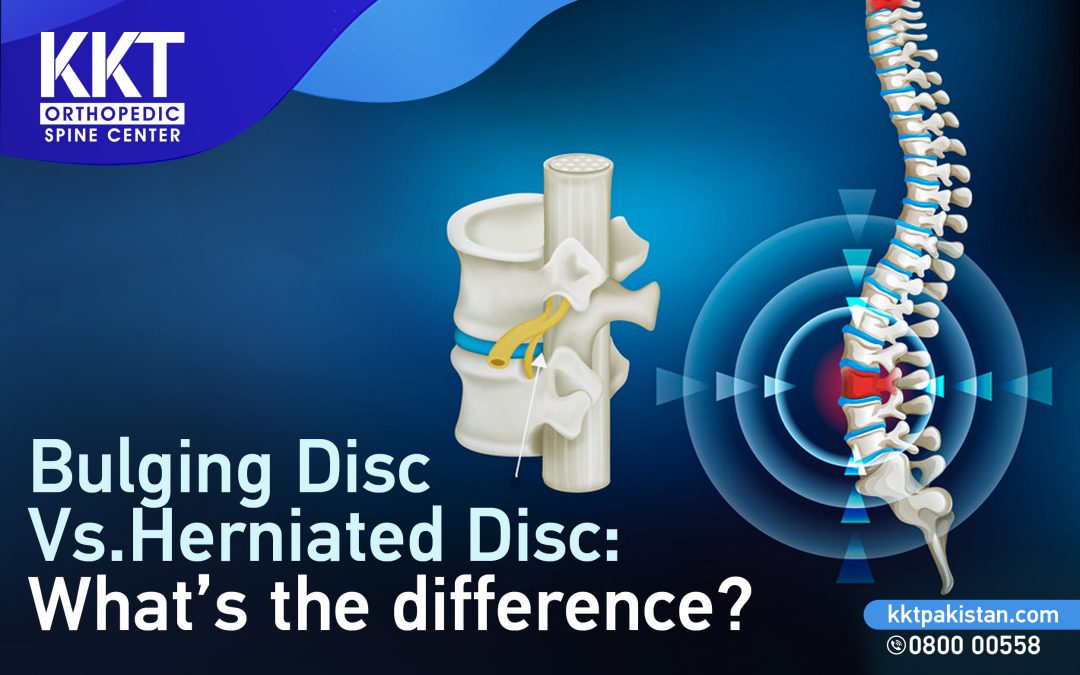Overview:
Before learning the difference between bulging disc and herniated disc, it’s important to understand the spine. Our spinal cord is made up of vertebrae, between these vertebrae lies intervertebral discs acting like shock absorbers. These discs are vital for a normally functioning spinal cord, they reduce stress, increases flexibility, and protect the nerves down the spine.
There are a total of 23 intervertebral discs in the human spine divided among cervical spine (6), thoracic spine (12), lumbar spine (5), and sacral (5). Three major components of these discs include:
- Nucleus Pulposus (NP), the inner part
- Annulus Fibrosus (AF), the outer part
- The two cartilaginous endplates, anchoring the discs to adjacent vertebrae
Types of Intervertebral Disc Disorders:
There are various kinds of intervertebral disc disorders. These conditions are more common in older people. They may also occur due to an injury. Disc disorders most commonly occur due to degeneration of the disc over time. With time the cartilage of these discs stiffens due to dehydration.
Two of the major types include:
- Bulging Disc
- Herniated Disc
Bulging Disc:
Movement of the nucleus pulposus out from its normal position. This bulging out of the nucleus into the spinal canal pinches the nerve root. In a bulging disc, the outer annulus is still intact keeping the nucleus inside. If the nucleus escapes, completely damaging the annulus this condition is called a disc herniation. A disc bulge doesn’t affect the entire perimeter of the intervertebral disc.
Causes of Bulging Disc: –
Three major causes of bulging disc include:
- Disc Degeneration due to aging
- Spinal Injury caused due to accidents
- Trauma or strain due to heavy lifting and bad posture
Herniated Disc:
Also known as a slipped or ruptured disc. This condition occurs when some of the nucleus pulposus is pushed out into the spinal canal through a tear in the annulus. Herniated disc compresses the nerve root or spinal canal. This condition can occur in any part of the spine (cervical, lumbar, thoracic, and sacral) but is more common in the lumbar region i-e: – lower back.
Symptoms of Herniated Disc:
A herniated disc can cause:
- Numbness and Weakness
- Pain in neck, shoulders, or lower back
Therefore, depending on where the disc herniation is in the spine. Herniated disc present in cervical spine results in neck, shoulder, and arm pain. Herniated discs usually affect only one side of the body.
Risk factors include:
- Weight, overweight puts pressure on the spine
- Genetics, family history of disc herniation
- Smoking reduces oxygen supply to the spine
- Occupation, physical jobs demanding heaving lifting, and bending
Difference between bulging disc and herniated disc:
Unlike a bulging disc, in a herniated disc, the nucleus breaks through the annulus into the outer layer. Whereas in a bulging disc, the annulus remains intact. In both cases, it exerts pressure on the nerve root. Disc herniation usually occurs in the final stage of degeneration. Slipped discs as well as herniated discs are most common in the lumbar spine.
Why KKT?
KKT Pakistan offers non-surgical treatment for the victims of spinal ailments, back and neck problems. The Treatment primarily focuses on the root cause of the pain. KKT has 8 operational centers across Pakistan. Cities include Lahore, Karachi, Rawalpindi, Peshawar, Faisalabad, Multan, and Hyderabad. KKT provides also provides treatment for intervertebral disc disorders including bulging and herniated disc. In case of any inconvenience related to the spine, book an appointment with your nearest KKT center.
For booking an appointment, kindly get in touch with us through our patient care line.
Phone: 0800-00-558
Or click on the link below.
